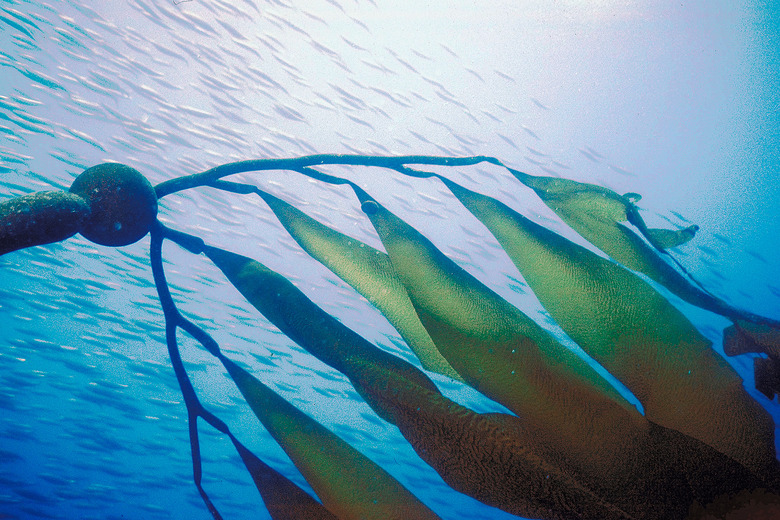What Plants Live In The Atlantic Ocean?
The Atlantic Ocean teems with life of all kinds. While the animals of the Atlantic Ocean garner much attention, there are also many varieties of plants and plantlike organisms. These Atlantic plants play essential roles for animals in different ocean ecosystems.
TL;DR (Too Long; Didn't Read)
Many plants live in the Atlantic Ocean. They range from tiny phytoplankton to seagrasses to large kelp and sea vegetables such as dulse and Irish moss.
Plants in the Atlantic Ocean
Plants in the Atlantic Ocean
Some of the tiniest organisms that can be considered plantlike are phytoplankton. These minuscule forms of Atlantic plants build the very foundation of entire ecosystems in the Atlantic Ocean. Seagrasses are other forms of plants in the Atlantic Ocean.
In addition to true plants, algae thrive in the Atlantic Ocean. Seaweeds such as kelp, sargassum, dulse and Irish moss proliferate in the Atlantic.
Phytoplankton: Tiny Atlantic Ocean Plants
Phytoplankton: Tiny Atlantic Ocean Plants
Phytoplankton are microorganisms that appear like tiny plants floating in ocean water. They use the green pigment chlorophyll to turn sunlight into energy. Phytoplankton form the basis of many ocean ecosystems. Fish, whales and other creatures rely on phytoplankton as food.
Phytoplankton populations in the Atlantic Ocean are sometimes visible by satellite imaging. When conditions allow for abundant nutrients, sunlight, and the right ocean temperatures, phytoplankton will bloom in massive swaths.
Along the Atlantic coast of southwestern Africa, spectacular phytoplankton blooms swirl in bright green, chlorophyll-rich populations. This area of the Benguela Current feeds a wealth of animal life in the sea.
Seagrass Plants in the Atlantic Ocean
Seagrass Plants in the Atlantic Ocean
There are many kinds of seagrass plants in the Atlantic Ocean. In the mid-Atlantic region, some examples include eelgrass (Zostera marina), horned pondweed (Zannichellia palustris), redhead grass (Potamogeton perfoliatus) and Widgeon grass (Ruppia maritima).
Seagrasses provide ideal habitats for several sea creatures. Seagrasses offer shelter, protective fish nursery areas and safe places to hide from predators.
The Great Atlantic Sargassum Belt
The Great Atlantic Sargassum Belt
Reputed for its namesake origin in the species-rich and ocean-bordered Sargasso Sea, sargassum is a kind of seaweed. These Atlantic Ocean plants are a type of seaweed that grows in clumps in the open ocean. Sargassum plants are considered holopelagi, or freely floating forms of algae that reproduce vegetatively. This method is different from other seaweeds that anchor and reproduce on the ocean floor.
Sargassum is an Atlantic Ocean plant that provides habitat for many Atlantic Ocean animals, from birds to fish, turtles, and crabs. But too much of this type of marine plant can cause problems.
Sargassum has, in recent years, undergone an incredible bloom that stretches almost entirely across the Atlantic Ocean. This Great Atlantic Sargassum Belt has persisted since 2011. This bloom was caused by nutrient-rich runoff from fertilizers used in farming, mostly from the Amazon River and West Africa.
Problems arise when sargassum sinks to the bottom of the ocean and chokes out corals and seagrasses. This bloom is a prime example of human activity disrupting whole ecosystems, and it remains to be seen how this will affect ocean life going forward.
Kelp in the Atlantic Ocean
Kelp in the Atlantic Ocean
Kelp is a form of brown algae that grows in what looks similar to a forest on the ocean floor. While the Atlantic Ocean does not have the giant kelp of the Pacific, it still houses many kelp species that thrive in their ocean ecosystems. Kelp is tremendously beneficial not only to animals, but also humans, who use it in foods, medicines, cosmetics, and construction.
Laminaria is a commonly found Atlantic Ocean kelp. It grows in forests that house numerous Atlantic Ocean animals, like sea bass, kelpfish, Garibaldis, crustaceans and worms. Larger fish and sea mammals drift among laminaria kelp forests as well. Kelp's chief predator is the sea urchin.
Different types of Atlantic Ocean kelp include oarweed (Laminaria digitata), dabberlocks (Alaria esculenta), furbelows (Saccorhiza polyschides), sugar kelp (Laminaria saccharina), and cuvie (Laminaria hyperborea). Cuvie grows as much as five meters in height in its North Atlantic habitat.
Edible Plants in the Atlantic Ocean
Edible Plants in the Atlantic Ocean
In addition to providing habitat and food for marine organisms, some Atlantic Ocean plants offer delicious and nutritious foods for humans. In addition to kelp, dulse and Irish moss are two kinds of Atlantic algae that balance out meals.
Dulses are a kind of red algae in the Atlantic that have leafy fronds. Dulse is often used in salads but also as a savory flavoring for foods like potatoes and eggs. Europeans have used dulse in their cooking for hundreds of years.
Another favorite type of red algae is Irish moss (Chondrus crispus). Irish moss is popular in both the northern Atlantic Ocean as well as in the Caribbean. It contains the thickening agent carrageenan and is often used in puddings.
Cite This Article
MLA
Hermance, Dianne. "What Plants Live In The Atlantic Ocean?" sciencing.com, https://www.sciencing.com/what-plants-live-in-the-atlantic-ocean-13404956/. 30 September 2021.
APA
Hermance, Dianne. (2021, September 30). What Plants Live In The Atlantic Ocean?. sciencing.com. Retrieved from https://www.sciencing.com/what-plants-live-in-the-atlantic-ocean-13404956/
Chicago
Hermance, Dianne. What Plants Live In The Atlantic Ocean? last modified March 24, 2022. https://www.sciencing.com/what-plants-live-in-the-atlantic-ocean-13404956/
